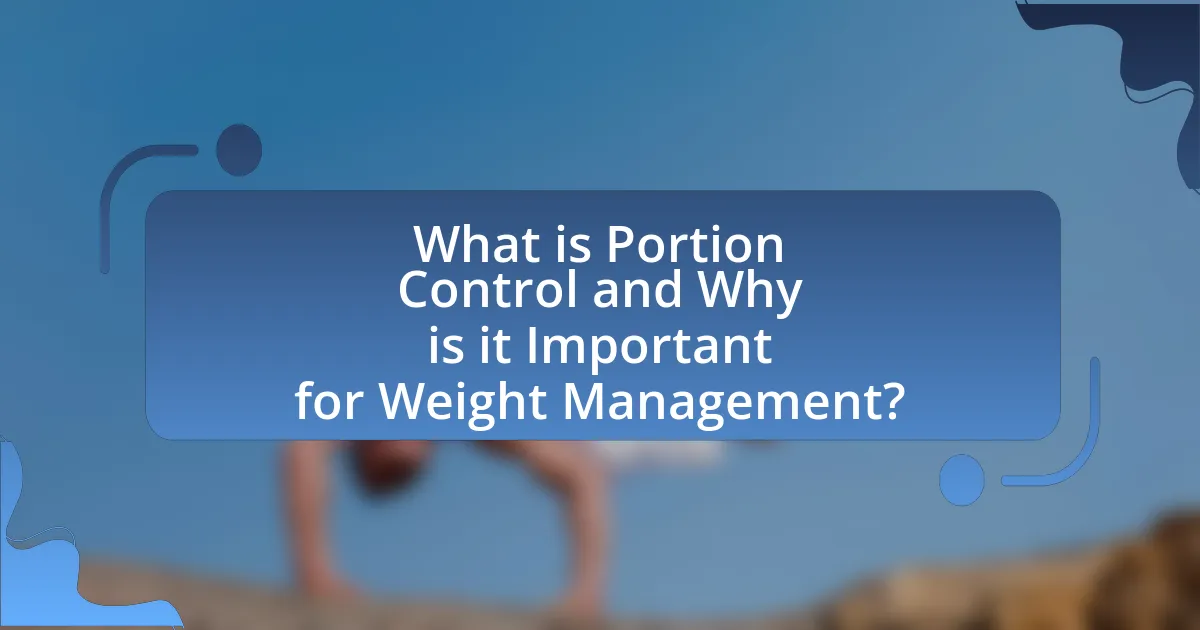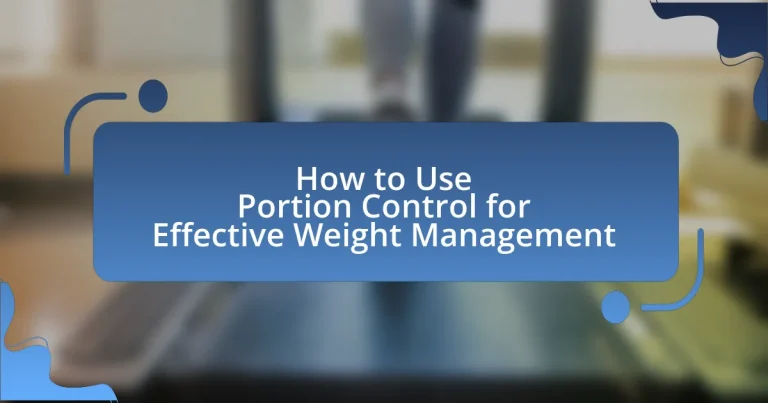Portion control is the practice of managing food intake by regulating serving sizes, which is essential for effective weight management. This article explores the significance of portion control in controlling calorie intake, influencing eating habits, and promoting healthier dietary choices. It discusses the psychological effects of portion sizes on appetite, various methods for implementing portion control, and practical strategies for daily life, including the use of measuring tools and mindful eating practices. Additionally, it addresses common misconceptions, challenges, and the impact of social situations on portion choices, providing a comprehensive guide to achieving and maintaining a healthy weight through effective portion management.

What is Portion Control and Why is it Important for Weight Management?
Portion control refers to the practice of managing the amount of food consumed in a single serving, which is crucial for effective weight management. By regulating portion sizes, individuals can better control calorie intake, leading to a balanced diet and weight loss or maintenance. Research indicates that larger portion sizes are linked to increased calorie consumption, contributing to obesity; for instance, a study published in the American Journal of Clinical Nutrition found that people tend to eat more when served larger portions, regardless of hunger levels. Therefore, implementing portion control can significantly aid in achieving and sustaining a healthy weight.
How does Portion Control influence eating habits?
Portion control significantly influences eating habits by regulating the amount of food consumed, which can lead to healthier dietary choices and weight management. When individuals practice portion control, they are more likely to avoid overeating, as studies indicate that larger portion sizes can lead to increased calorie intake. Research published in the American Journal of Clinical Nutrition found that participants who were served larger portions consumed 30% more calories than those with smaller portions. This demonstrates that controlling portion sizes can help individuals better manage their caloric intake and promote healthier eating patterns.
What are the psychological effects of portion sizes on appetite?
Portion sizes significantly influence appetite through psychological mechanisms such as visual cues and satiety perception. Research indicates that larger portion sizes can lead to increased consumption, as individuals often rely on visual indicators to gauge how much to eat rather than their internal hunger signals. A study published in the American Journal of Clinical Nutrition by Wansink and van Ittersum (2013) found that participants served larger portions consumed 30% more food than those with smaller portions, demonstrating the impact of portion size on eating behavior. This reliance on external cues can override physiological hunger cues, leading to overeating and potential weight gain.
How can portion control help in reducing calorie intake?
Portion control helps in reducing calorie intake by limiting the amount of food consumed in a single sitting, which directly decreases overall calorie consumption. Research indicates that individuals who practice portion control tend to eat fewer calories, as smaller portions can lead to lower energy intake without sacrificing satisfaction. A study published in the American Journal of Clinical Nutrition found that participants who were given smaller portion sizes consumed approximately 20% fewer calories compared to those with larger portions. This demonstrates that managing portion sizes effectively can lead to significant reductions in calorie intake, supporting weight management efforts.
What are the different methods of Portion Control?
The different methods of portion control include using measuring tools, visual cues, pre-portioned meals, and mindful eating practices. Measuring tools, such as cups and scales, provide precise serving sizes, helping individuals adhere to recommended portions. Visual cues involve using smaller plates or bowls to create the illusion of a fuller plate, which can reduce overall intake. Pre-portioned meals, often found in meal kits or frozen dinners, eliminate guesswork and promote consistent portion sizes. Mindful eating practices encourage individuals to focus on their food, recognize hunger cues, and slow down during meals, which can lead to better portion awareness and satisfaction. These methods are supported by research indicating that portion control can significantly impact weight management and dietary habits.
How can measuring tools assist in portion control?
Measuring tools assist in portion control by providing accurate measurements of food quantities, which helps individuals adhere to recommended serving sizes. These tools, such as measuring cups, spoons, and food scales, enable users to quantify their food intake, reducing the likelihood of overeating. Research indicates that individuals who use measuring tools are more successful in managing their weight, as they can better align their consumption with dietary guidelines. For instance, a study published in the Journal of the Academy of Nutrition and Dietetics found that participants who utilized measuring tools consumed 25% fewer calories compared to those who did not. This evidence underscores the effectiveness of measuring tools in promoting mindful eating and supporting weight management goals.
What role do visual cues play in managing portion sizes?
Visual cues significantly influence the management of portion sizes by affecting individuals’ perceptions of how much food is appropriate to consume. Research indicates that larger plates and bowls can lead to increased portion sizes, as people tend to fill their dishes based on the size of the container rather than their actual hunger levels. A study published in the American Journal of Clinical Nutrition found that participants served themselves 31% more food when using larger plates compared to smaller ones, demonstrating the direct impact of visual cues on portion control. Thus, visual cues play a crucial role in shaping eating behaviors and can be strategically utilized to promote healthier portion sizes.
Why is Portion Control essential for sustainable weight loss?
Portion control is essential for sustainable weight loss because it helps regulate calorie intake, which is crucial for creating a calorie deficit necessary for weight loss. By managing portion sizes, individuals can enjoy a variety of foods while preventing overeating, which is a common barrier to weight loss. Research indicates that people often underestimate portion sizes, leading to increased calorie consumption; for instance, a study published in the American Journal of Clinical Nutrition found that larger portion sizes can lead to a 30% increase in calorie intake. Therefore, practicing portion control not only aids in maintaining a balanced diet but also supports long-term weight management by fostering mindful eating habits.
How does portion control contribute to long-term weight maintenance?
Portion control contributes to long-term weight maintenance by helping individuals regulate their calorie intake, which is essential for sustaining a healthy weight. By consuming appropriate serving sizes, individuals can prevent overeating and manage their energy balance effectively. Research indicates that people who practice portion control are more likely to maintain their weight loss over time; a study published in the American Journal of Clinical Nutrition found that participants who used portion control strategies were able to sustain a weight loss of 10% or more for at least one year. This demonstrates that portion control is a practical and effective method for achieving and maintaining long-term weight management.
What are the common misconceptions about portion sizes?
Common misconceptions about portion sizes include the belief that larger servings are necessary for satisfaction and that all food groups should be consumed in equal amounts. Many individuals assume that restaurant portions reflect appropriate serving sizes, leading to overeating. Research indicates that people often underestimate portion sizes, with studies showing that individuals can misjudge a serving by up to 50%. Additionally, the idea that “healthy” foods can be consumed in unlimited quantities is misleading, as calorie density still applies. Understanding these misconceptions is crucial for effective weight management.
How can one effectively implement Portion Control in daily life?
To effectively implement portion control in daily life, individuals should use measuring tools such as cups and scales to accurately gauge serving sizes. Research indicates that people often underestimate portion sizes, leading to increased calorie intake; for example, a study published in the American Journal of Clinical Nutrition found that participants who used measuring tools consumed 25% fewer calories than those who did not. Additionally, individuals can benefit from using smaller plates and bowls, which can create the illusion of larger portions and help reduce overall food consumption. By being mindful of serving sizes and utilizing these practical strategies, individuals can successfully manage their portions and support their weight management goals.
What challenges might arise when practicing Portion Control?
Practicing portion control can lead to several challenges, including difficulty in accurately measuring food portions, psychological resistance to smaller servings, and social pressures during meals. Accurately measuring food can be complicated, as many individuals lack the tools or knowledge to determine appropriate serving sizes, leading to either underestimating or overestimating portions. Psychological resistance often manifests as discomfort or dissatisfaction when consuming smaller amounts of food, which can trigger feelings of deprivation and lead to overeating. Additionally, social situations, such as dining with friends or family, can create pressure to eat larger portions or indulge in shared dishes, making it harder to adhere to portion control practices. These challenges can hinder effective weight management efforts.

What are the practical strategies for Portion Control?
Practical strategies for portion control include using smaller plates, measuring serving sizes, and being mindful of hunger cues. Smaller plates can visually trick the brain into perceiving a full plate, which can reduce overall food intake. Measuring serving sizes helps individuals understand appropriate portions, as studies show that people often underestimate the amount they eat. Additionally, paying attention to hunger cues encourages individuals to eat only when hungry and stop when satisfied, which can lead to healthier eating habits and effective weight management.
How can meal planning enhance Portion Control?
Meal planning enhances portion control by allowing individuals to pre-define serving sizes and create balanced meals in advance. This structured approach reduces the likelihood of overeating, as it encourages adherence to specific portion sizes rather than impulsive eating. Research indicates that individuals who engage in meal planning are more successful in managing their weight, as they can better track caloric intake and nutritional balance. A study published in the Journal of Nutrition Education and Behavior found that meal planning is associated with healthier eating patterns and improved portion sizes, demonstrating its effectiveness in promoting portion control.
What are the benefits of preparing meals in advance?
Preparing meals in advance offers several benefits, particularly for effective weight management. First, it allows individuals to control portion sizes, which is crucial for maintaining a balanced diet and preventing overeating. Research indicates that pre-portioned meals can lead to a reduction in caloric intake, as individuals are less likely to consume extra servings when meals are pre-prepared. Additionally, meal prep saves time during the week, reducing the likelihood of resorting to unhealthy convenience foods. A study published in the Journal of Nutrition Education and Behavior found that individuals who engage in meal preparation are more likely to make healthier food choices and adhere to their dietary goals. Overall, preparing meals in advance supports better portion control and promotes healthier eating habits.
How can portioning snacks help in managing cravings?
Portioning snacks can help in managing cravings by controlling the amount of food consumed, which prevents overeating and maintains balanced energy levels. When snacks are pre-portioned, individuals are less likely to mindlessly consume large quantities, thereby reducing the likelihood of experiencing intense cravings later. Research indicates that people who use portion control techniques are more successful in weight management, as they can satisfy their hunger without exceeding their caloric needs. For example, a study published in the journal “Appetite” found that participants who used portion control strategies reported lower levels of hunger and fewer cravings compared to those who did not.
What role does mindfulness play in Portion Control?
Mindfulness plays a crucial role in portion control by enhancing awareness of hunger and satiety cues. When individuals practice mindfulness, they become more attuned to their eating habits, allowing them to recognize when they are truly hungry versus eating out of habit or emotional triggers. Research indicates that mindfulness-based interventions can lead to significant reductions in portion sizes consumed, as individuals learn to slow down and savor their food, which promotes better digestion and satisfaction. A study published in the journal “Appetite” found that participants who engaged in mindful eating consumed 30% fewer calories compared to those who did not practice mindfulness, demonstrating its effectiveness in managing portion sizes for weight control.
How can mindful eating practices improve portion awareness?
Mindful eating practices can significantly improve portion awareness by encouraging individuals to focus on their eating experience, which helps them recognize hunger and fullness cues. This heightened awareness allows individuals to better gauge appropriate portion sizes, leading to more intentional eating habits. Research indicates that individuals who engage in mindful eating are less likely to overeat, as they are more attuned to their body’s signals and the sensory aspects of food, such as taste and texture. A study published in the journal “Appetite” found that participants who practiced mindful eating reported a decrease in portion sizes and an increase in satisfaction with smaller amounts of food, demonstrating the effectiveness of these practices in enhancing portion control.
What techniques can help in recognizing hunger and fullness cues?
Techniques that can help in recognizing hunger and fullness cues include mindful eating, keeping a food journal, and using hunger scales. Mindful eating encourages individuals to pay attention to their eating experience, focusing on the taste, texture, and aroma of food, which can enhance awareness of hunger and fullness signals. Research indicates that individuals who practice mindful eating are more likely to recognize their body’s cues effectively, leading to better portion control and weight management. Keeping a food journal allows individuals to track their eating patterns and emotional triggers, helping them identify when they are truly hungry versus eating out of habit or emotion. Additionally, using hunger scales, which rate hunger and fullness from 1 to 10, can provide a structured way to assess physical sensations related to hunger and satiety, promoting more conscious eating decisions.

What are the common pitfalls in Portion Control and how to avoid them?
Common pitfalls in portion control include using oversized plates, not measuring food, and eating while distracted. Oversized plates can lead to larger servings, as studies show that people tend to fill their plates regardless of size, resulting in increased calorie intake. To avoid this, use smaller plates to create the illusion of a full meal. Not measuring food can lead to underestimating portion sizes; research indicates that individuals often misjudge serving sizes, leading to excessive consumption. To counter this, utilize measuring cups or a food scale to ensure accurate portions. Eating while distracted, such as watching TV or using smartphones, can result in mindless eating, which is linked to overeating. To prevent this, focus on meals without distractions, promoting mindfulness and awareness of hunger cues.
How can social situations impact Portion Control?
Social situations can significantly impact portion control by influencing eating behaviors and perceptions of appropriate serving sizes. In social settings, individuals often feel pressure to conform to group norms, which can lead to larger portion sizes being consumed. Research indicates that people tend to eat more when dining with others compared to eating alone; a study published in the American Journal of Clinical Nutrition found that individuals consumed 44% more food in social settings. Additionally, the presence of shared dishes can encourage overeating, as individuals may serve themselves more than they would if they were eating alone. This social influence can disrupt personal portion control strategies, making it challenging to adhere to dietary goals.
What strategies can be used to manage portions when dining out?
To manage portions when dining out, individuals can employ several effective strategies. One strategy is to share dishes with others, which allows for smaller individual portions while still enjoying a variety of flavors. Another approach is to request half portions or appetizers as main courses, which can significantly reduce calorie intake. Additionally, using a smaller plate can create the illusion of a fuller plate, helping to control portion sizes. Research indicates that people tend to eat more when served larger portions; thus, being mindful of serving sizes can aid in weight management. Finally, taking time to eat slowly and savor each bite can enhance satisfaction and reduce the likelihood of overeating.
How can peer pressure affect portion choices?
Peer pressure can significantly influence portion choices by encouraging individuals to conform to the eating behaviors of their peers. When in social settings, individuals may feel compelled to eat larger portions to align with the group, leading to increased calorie intake. Research indicates that people often adjust their food consumption based on the eating habits of those around them; for instance, a study published in the journal “Appetite” found that individuals consumed 35% more food when dining with others who were eating larger portions. This social influence can undermine personal portion control efforts and contribute to unhealthy eating patterns.
What are the signs of ineffective Portion Control?
Ineffective portion control is indicated by consistently overeating, feeling uncomfortably full after meals, and frequently snacking between meals. These signs suggest a lack of awareness regarding appropriate serving sizes and can lead to weight gain. Research shows that individuals who do not accurately gauge portion sizes are more likely to consume excess calories, contributing to obesity and related health issues. For instance, a study published in the American Journal of Clinical Nutrition found that people often underestimate portion sizes, leading to increased caloric intake.
How can one identify if they are overeating despite portion control efforts?
One can identify if they are overeating despite portion control efforts by monitoring physical and emotional cues related to hunger and satiety. If an individual consistently feels uncomfortably full after meals, experiences frequent cravings shortly after eating, or relies on food for emotional comfort, these may indicate overeating. Research shows that mindful eating practices, such as paying attention to hunger signals and eating slowly, can help individuals recognize these patterns. A study published in the journal “Appetite” by van Strien et al. (2016) found that emotional eating and lack of awareness of satiety can lead to increased caloric intake, even when portion sizes are controlled.
What steps can be taken to recalibrate portion sizes if needed?
To recalibrate portion sizes, individuals can start by measuring food using standard serving sizes, such as cups or ounces, to establish a baseline. This method allows for accurate assessment of current portion sizes compared to recommended guidelines. Additionally, using smaller plates and bowls can visually reduce portion sizes, making meals appear more substantial while actually consuming less. Tracking food intake through a journal or app can provide insights into portion sizes and help identify areas for adjustment. Research indicates that people often underestimate portion sizes, so being mindful and intentional about serving sizes can lead to better weight management outcomes.
What are the best practices for successful Portion Control?
The best practices for successful portion control include using smaller plates, measuring serving sizes, and being mindful of hunger cues. Smaller plates can create the illusion of a fuller plate, which may help reduce overall food intake. Measuring serving sizes ensures that individuals are aware of how much they are consuming, which can prevent overeating. Additionally, paying attention to hunger cues allows individuals to eat only when they are truly hungry, rather than out of habit or boredom. Research indicates that these strategies can lead to a significant reduction in calorie intake, supporting effective weight management.


